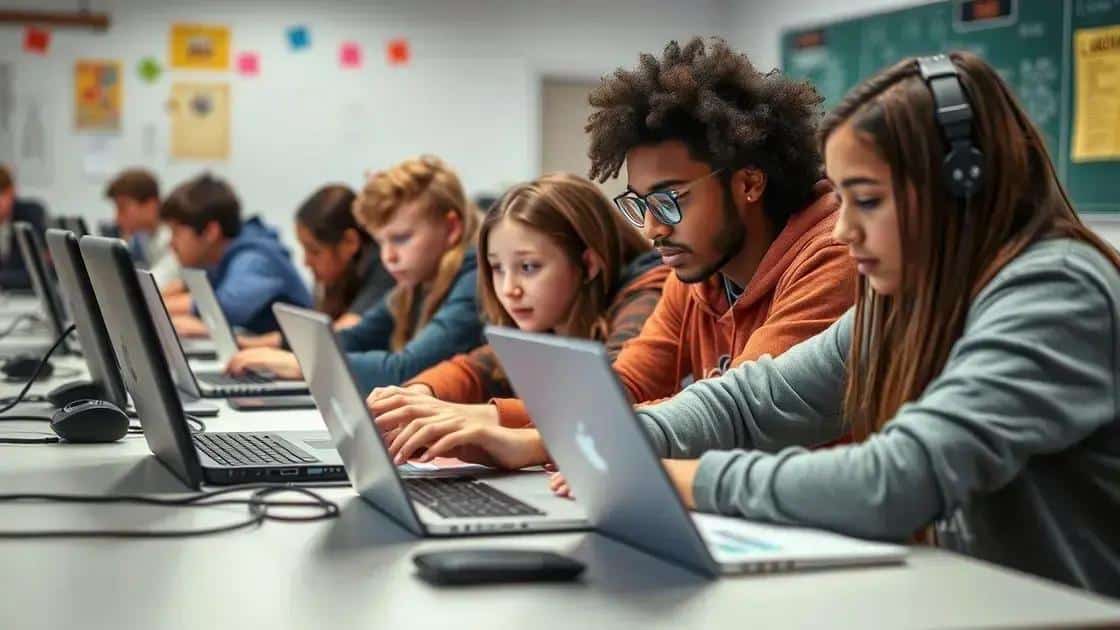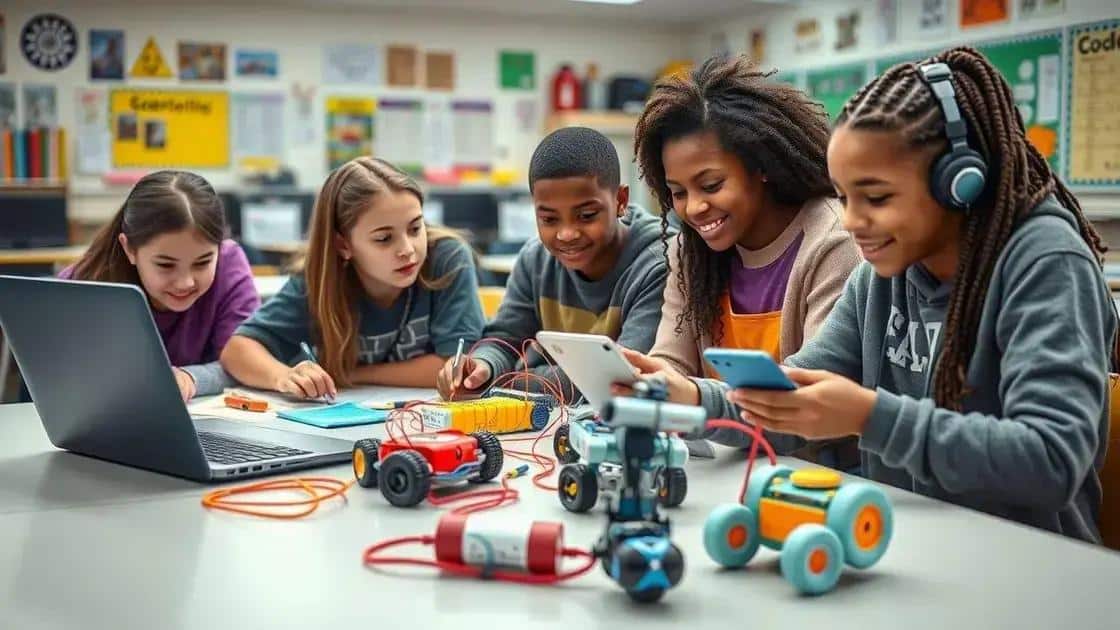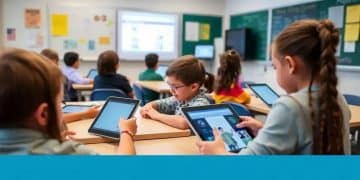Insights on high school coding classes: A path to tech careers

High school coding classes enhance students’ skills in programming, creativity, and problem-solving, while utilizing resources like online platforms, hands-on tools, and community engagement to prepare them for future careers in a technology-driven world.
Insights on high school coding classes reveal how essential they are for shaping future careers in technology. With the world moving towards digital solutions, understanding coding can be a game-changer for students. Have you considered how these classes might impact your learning journey?
The significance of coding in today’s job market
Understanding the significance of coding in today’s job market is crucial for students. Coding skills are no longer just a niche area; they are becoming essential for a wide range of careers. This knowledge opens up numerous opportunities and enhances problem-solving abilities.
Demand for Coding Skills
Many industries seek employees with coding skills. Whether in tech, finance, healthcare, or entertainment, coding abilities are highly sought after. Companies appreciate individuals who can understand and manipulate technology.
Enhancing Career Opportunities
Learning to code can greatly enhance a student’s job prospects.
- Employers favor candidates with coding experience.
- Many high-paying jobs require coding knowledge.
- It enables individuals to work on innovative projects and solutions.
- Coding teaches valuable skills like logical thinking and creativity.
As businesses grow more reliant on technology, the ability to code becomes increasingly valuable. It encourages a greater understanding of how software interacts with other components in business operations. This insight is beneficial not only for tech-related roles but for any profession in the digital era.
Furthermore, the rise of automation and artificial intelligence highlights the need for coding in diverse sectors. As these technologies evolve, so do the roles required to manage and implement them effectively.
Conclusion
In summary, recognizing the significance of coding is essential for anyone considering their career path. As today’s job market shifts, equipping oneself with coding skills provides a competitive edge and prepares students for the future.
Key skills taught in high school coding classes

High school coding classes equip students with essential skills that are valuable in today’s digital world. These classes cover a range of topics that not only teach programming but also foster critical thinking and creativity.
Programming Languages
Students learn various programming languages, which allows them to understand different coding environments. Common languages include:
- Python – Known for its simplicity and versatility.
- Java – Widely used in enterprise applications.
- JavaScript – Essential for web development.
- HTML/CSS – Fundamental for creating websites.
Each language has its own strengths and is suitable for different applications, making it important for students to have exposure to multiple languages.
Problem-Solving Techniques
Coding fosters strong problem-solving skills. Students learn how to break down complex tasks into manageable parts. This ability is applicable in various aspects of life and work. Additionally, they explore algorithms, which are step-by-step procedures for solving problems, enhancing their logical thinking.
Collaboration is another critical skill honed in coding classes. Students often work in groups to complete projects. This teamwork teaches them to communicate effectively and view challenges from different perspectives.
Coding also introduces students to version control systems like Git. These tools help track changes in projects and are key practices in software development. Understanding these systems prepares students for real-world coding environments.
Moreover, learning to build projects encourages creativity. As students create apps or websites, they express their ideas while applying their skills. This combination of technical training and creative expression is vital for a balanced educational experience.
How coding classes foster creativity and problem-solving
Coding classes play a vital role in fostering both creativity and problem-solving skills among students. By engaging in coding, students explore imaginative ways to create and think critically about their projects.
Encouraging Creative Thinking
When students learn to code, they are not just following steps; they are inventing solutions. This process offers an opportunity to be creative, as they often design their projects from scratch. Coding enables students to visualize their ideas and transform them into reality. As they write code to build apps or websites, they learn how to balance functionality with aesthetic appeal.
Problem-Solving Strategies
Coding is inherently about solving problems. Students face challenges that require them to think analytically and methodically. When they encounter an error in their code, they must diagnose the issue and find a solution through testing and adjusting their work.
- They develop resilience as they troubleshoot and refine their projects.
- Critical thinking is enhanced when they analyze different approaches to solve a problem.
- Collaboration with peers fosters a shared learning environment for tackling complex challenges.
As students continue to learn, they often find unconventional ways to address difficult problems. This thought process is not just limited to coding; it spills over into everyday situations, equipping them with skills they will use throughout their lives.
The creative aspect of coding helps students express themselves in unique ways. Whether they are designing games, animations, or interactive websites, their personal interests and passions find a place in their work. This blend of creativity and structured thinking leads to well-rounded individuals prepared for various challenges.
Resources for enhancing high school coding programs

Enhancing high school coding programs relies on a variety of resources that can enrich the learning experience for students. By utilizing these resources, educators can create a more engaging and effective curriculum.
Online Platforms and Courses
Several online platforms offer free and paid courses that cater to different skill levels. These platforms provide interactive learning experiences that can complement classroom instruction.
- Codecademy – Great for beginners learning programming concepts and languages.
- Khan Academy – Offers comprehensive courses in computer programming and computer science.
- Coursera – Partners with universities to provide specialized coding courses.
- edX – Features courses from top universities that often include a free option.
These platforms can motivate students to learn at their own pace while providing good examples of real-world applications.
Community and Collaboration
Building a community around coding enhances student engagement. Schools can invite local tech professionals for guest lectures or organize coding workshops. Students benefit from seeing how coding skills apply in actual jobs. Furthermore, joining coding clubs or participating in competitions can also encourage collaboration and mentorship.
Additionally, educators can collaborate with other schools to share resources and best practices. This networking can help expand the available tools and knowledge to enrich coding programs.
Hands-On Resources
Incorporating hands-on activities is crucial for enhancing coding programs. Using tools like Arduino and Raspberry Pi allows students to see the practical application of code. They can create real projects that blend coding with electronics, which solidifies their knowledge while nurturing their creativity.
Purchasing software licenses for programs like Code.org or Scratch can also provide structured curriculums and resources that guide teachers in delivering coding lessons.
In conclusion, enhancing high school coding programs is a beneficial step for students today. These programs not only teach essential coding skills but also encourage creativity and problem-solving. By utilizing various resources, schools can significantly improve the coding experience for students. Involving the community and using hands-on tools make learning to code exciting and impactful. With strong support, students are better prepared for future challenges in a tech-driven world.
FAQ – Frequently Asked Questions about High School Coding Programs
What are the benefits of coding classes for high school students?
Coding classes equip students with essential skills, foster creativity, and enhance problem-solving abilities, preparing them for future careers.
Which resources can enhance a high school coding program?
Resources include online platforms like Codecademy, community workshops, hands-on tools like Arduino, and collaboration with local tech professionals.
How do coding classes encourage teamwork among students?
Students often work in groups on projects, which helps them develop collaboration and communication skills necessary for both school and future work environments.
Can coding skills be applied outside of technology jobs?
Yes, coding skills are valuable in many fields, such as marketing, finance, and education, as they promote logical thinking and problem-solving regardless of the profession.





